James Lockhart Perry's Blog, page 16
January 5, 2014
Schaerbeek
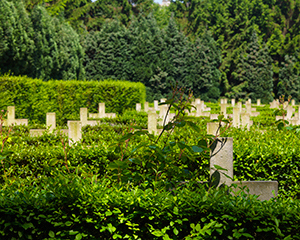 This tiny, hidden cemetery in a Flemish suburb of Bruxelles was originally cleared for the Tir National, a rifle range for training Belgian sharpshooters. In both World Wars, I and II, the German occupation authorities took advantage of its hidden location to use it as an execution ground for judicially convicted foreigners. In this capacity, it became the site of one of the great blunders of modern military diplomacy, when on October 12, 1915, the German authorities under the wooden-headed Baron von der Lancken stood the woman Edith Cavell up against the earthen embankment here and shot her for treason.
This tiny, hidden cemetery in a Flemish suburb of Bruxelles was originally cleared for the Tir National, a rifle range for training Belgian sharpshooters. In both World Wars, I and II, the German occupation authorities took advantage of its hidden location to use it as an execution ground for judicially convicted foreigners. In this capacity, it became the site of one of the great blunders of modern military diplomacy, when on October 12, 1915, the German authorities under the wooden-headed Baron von der Lancken stood the woman Edith Cavell up against the earthen embankment here and shot her for treason.
Technically, Edith might have been guilty of the charges. She was a proper English nurse who ran clinics and teaching schools for the Red Cross in Belgium. She saved the lives of countless wounded soldiers–German, French, English, or Belgian–without worrying about their nationalities and afterwards helped send the healthy individuals back to their own countries. In a war where millions died and millions more served, she might have been responsible for passing less than two hundred Allied soldiers through the lines into neutral Holland.
The Germans could not have picked a worse–in other words, a nicer, more honest and brave–candidate to make their point. Edith remained composed and forthcoming throughout her interrogation and trial and admitted to everything. She justified her life as a wartime nurse by saying, “I can’t stop while there are lives to be saved.” And as if that weren’t bad enough, her last words, reported by the Reverend Stirling Gahan, were, “Patriotism is not enough. I must have no hatred or bitterness towards anyone.”
Coming five months after the Lusitania fiasco and fifteen months before the Zimmermann Telegram, this judicial murder proved a gold mine for the British propagandists. It crystalized war-weary public support in Britain and did as much as anything to bring the reluctant United States into the war. The Germans never got the point and defended the decision through the end of the war–even going so far as to execute another perfect propaganda candidate, Gabrielle Petit (who definitely was a spy, not that anyone cared by then), on the same spot on the evening of 1 April, 1916.
L’Enclos des Fusillés, as it is now known, houses the graves of several dozen judicially executed Belgian patriots from both wars, many of the crosses adorned with rosebushes and sad photo medallions of the dapper, young victims. The tiny plot and its thick, wavy walls of spruce trees are surprisingly hard to find, but maintained with meticulous care. In the morning, you can hear the traffic from the surrounding town waking up, but it only serves to underline the value lost in the lives that ended here.
Filed under: Travels Tagged: Belgium, Travel

January 4, 2014
Köln
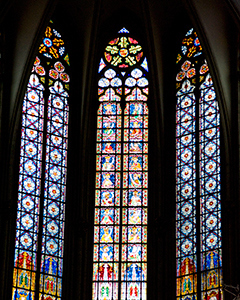 The stories people tell their children… Lockhart’s mother always had a thing for this gorgeous cathedral in the heart of Cologne. She could sit for hours in its long, dark nave, while her children shivered around her in the chill and dreamed of pea soup and sausages in warmer German beer halls. And maybe it was the fact that we lived just north of Coventry in England at the time, but she always tied together the fates of the two architectural wonders in her stories about World War II.
The stories people tell their children… Lockhart’s mother always had a thing for this gorgeous cathedral in the heart of Cologne. She could sit for hours in its long, dark nave, while her children shivered around her in the chill and dreamed of pea soup and sausages in warmer German beer halls. And maybe it was the fact that we lived just north of Coventry in England at the time, but she always tied together the fates of the two architectural wonders in her stories about World War II.
According to Mom, the British struck here first, and Adolf Hitler was so incensed, or at least embarrassed, by the unnecessary destruction of this church that he ordered the demolishing of the cathedral in Coventry. The facts are a little murky, but the deadly German Blitz on Coventry of 14 November, 1940, was preceded by a relatively small British attack on Cologne on the night of 12 May in the same year. Doesn’t sound like much of a connection.
The main source of Mom’s indignation that has been conclusively proven as factual was the utter pointlessness of the World War II raids on populations and architectural icons worldwide. For six years, the most sophisticated planetary leadership in history went bezerk with the full support of their populations in wreaking the most maniacal havoc on each other from the air. To put it in some sort of perspective, this cathedral took 632 years and two months (and billions in today’s money) to build, but just hours to nearly demolish. And with the fall of the Berlin Wall in 1989, national borders were reset to pretty much the same outlines they had traced before the madness began.
Today, the ruins of Coventry Cathedral still stand next to their replacement as a stark and spooky reminder of what the American Hopi Indians have called Koyaanisqatsi, or World Gone Crazy. The cathedral in Cologne, on the other hand, shows no evidence whatsoever of the war. This probably says as much as anything about the British and German views of both the past and the future.
Filed under: Travels Tagged: Germany, Travel

Kadiköy
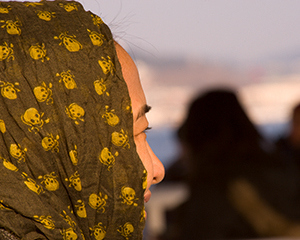 The political classes are forever looking for symbols to either crystalize their support or distract from the failure of their policies. No symbol has remained more potent, persistent, and perhaps ridiculous than the headscarf. We would dismiss the entire brouhaha, if it wasn’t for Mustafa Kemal Atatürk, one of the smartest men to ever rule a country, who started the pot boiling over the headscarf, and Habib in general, all of the way back in 1920s Turkey.
The political classes are forever looking for symbols to either crystalize their support or distract from the failure of their policies. No symbol has remained more potent, persistent, and perhaps ridiculous than the headscarf. We would dismiss the entire brouhaha, if it wasn’t for Mustafa Kemal Atatürk, one of the smartest men to ever rule a country, who started the pot boiling over the headscarf, and Habib in general, all of the way back in 1920s Turkey.
In the Occident, the scarf is feared as a threat to the core values of an entire civilization (all you have to do is find a way to insert the word Al-Qaeda into the conversation, and you even get the Americans’ attention). Put a fragment of cloth on your head, and you can be arrested for disturbing someone’s peace or worse.
In the Orient, politicians get elected by promising to allow headscarf wearers into public facilities. When they pass the enabling legislation, thousands come out in protest. When the courts overturn the law, thousands more come out in protest.
Our position on the controversy is that headscarves–at least the endless variation you find in the streets of Istanbul–and long, shiny, black hair both make terrific additions to any photo. And we might be hopelessly naïve, but once you factor out the usual bigotry on both sides, we suspect that ordinary people care no more than we do. It’s just what some people do.
One thing we’ve noticed (again, we’re quite possibly being naïve) is that in the West, you don’t see a lot of headscarf wearers smiling–they’re too intent on being good Muslim women. In Istanbul, on the other hand, where headscarves abound, the wearers look no more or less serious than anyone else.
Head-covering in a mosque, of course, is an entirely different issue, and we wholeheartedly support this. In fact, we miss the days when tourists were expected to show respect and cover their shoulders, legs, and heads in the great Christian cathedrals of the West. Just try to pray during high season with bubble gum and flash cameras popping in your ears, and you’ll know what we mean.
One final fragment: On New Year’s Eve, we watched a pair of young Turkish girls in five-inch heels and reasonably outrageous mini-skirts running down a street after a taxi. The sight so offended a nearby pair of young Muslim men, that they started bellowing one epithet after another at them. The girls laughed it off, but the noise was enough to bring the normally busy Istanbuli street to a halt while people checked out the controversy. A minute later, everyone returned to what they were doing and forgot about it.
Civilizations clash all over the planet in some of the least civilized ways–but then that’s what civilizations have been doing forever.
Filed under: Travels Tagged: Travel, Turkey

Stambul
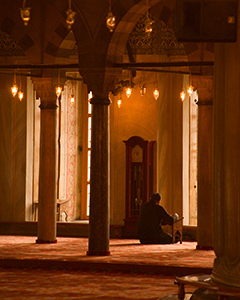 For someone brought up on Christian churches, East or West, Orthodox, Roman Catholic, or Protestant, the simplicity of the great Islamic mosques of Istanbul can be both over- and underwhelming.
For someone brought up on Christian churches, East or West, Orthodox, Roman Catholic, or Protestant, the simplicity of the great Islamic mosques of Istanbul can be both over- and underwhelming.
We’re reminded of a church Across Market in San Francisco, where the saints’ statues crowd the aisles as thickly as a New York subway station at rush hour. Or the top of the Duomo of Milano, with its hundreds of wise old men raining down marble benedictions on the city.
Of course, no one really knows what any of the truly ancient saints looked like, so the chances are, you’re praying to a likeness of the sculptor’s father, best friend, or some wealthy patron with a wad of commissions to hand out. Still, western churchgoers always seem to be asking some ancient saint or Christ figure to intercede with an angry, or at least impatient God.
And then you arrive in the Sultan Ahmet Camii or Blue Mosque in European Istanbul, and all you find is a huge, empty cavern. Beautiful carpets, fascinating tiles and lights, a lovely altar of sorts, and nice stained glass windows (although the Venetian originals are long gone). But no human likenesses of any kind–you just have to do your own talking to God.
Architecturally speaking, the dome itself is the main event, of course. At the time of construction, when Ottoman Turks ruled the world, the domes of these mosques represented an astonishing achievement of world-class science and mathematics. Give or take an earthquake or two, they have withstood the test of time just as well as most great western cathedrals with their long, airy naves and flying buttresses.
It is a fascinating bit of history that the basic design for these grand buildings came from the Byzantine Christian church across the park from this mosque, the Aya Sofia. And that the Kaaba in Mecca is said to have been built by Abraham, the father of both the Jewish and Christian faiths. It makes one wonder about all of the wars fought and still waiting to be fought between Islam and Christianity.
Still, even a Christian looking for a saint to talk to can’t help but admire the beauty and simplicity of an old man reading the Qur’an and gazing out a window at one of the great human cities of the world while kneeling next to the only decoration in the room, a functioning grandfather clock. Time might be passing, but you’d never know it.
Filed under: Travels Tagged: Travel, Turkey

Istanbul
 For someone brought up on Christian churches, East or West, Orthodox, Roman Catholic, or Protestant, the simplicity of the great Islamic mosques of Istanbul can be both over- and underwhelming.
For someone brought up on Christian churches, East or West, Orthodox, Roman Catholic, or Protestant, the simplicity of the great Islamic mosques of Istanbul can be both over- and underwhelming.
We’re reminded of a church Across Market in San Francisco, where the saints’ statues crowd the aisles as thickly as a New York subway station at rush hour. Or the top of the Duomo of Milano, with its hundreds of wise old men raining down marble benedictions on the city.
Of course, no one really knows what any of the truly ancient saints looked like, so the chances are, you’re praying to a likeness of the sculptor’s father, best friend, or some wealthy patron with a wad of commissions to hand out. Still, western churchgoers always seem to be asking some ancient saint or Christ figure to intercede with an angry, or at least impatient God.
And then you arrive in the Sultan Ahmet Camii or Blue Mosque in European Istanbul, and all you find is a huge, empty cavern. Beautiful carpets, fascinating tiles and lights, a lovely altar of sorts, and nice stained glass windows (although the Venetian originals are long gone). But no human likenesses of any kind–you just have to do your own talking to God.
Architecturally speaking, the dome itself is the main event, of course. At the time of construction, when Ottoman Turks ruled the world, the domes of these mosques represented an astonishing achievement of world-class science and mathematics. Give or take an earthquake or two, they have withstood the test of time just as well as most great western cathedrals with their long, airy naves and flying buttresses.
It is a fascinating bit of history that the basic design for these grand buildings came from the Byzantine Christian church across the park from this mosque, the Aya Sofia. And that the Kaaba in Mecca is said to have been built by Abraham, the father of both the Jewish and Christian faiths. It makes one wonder about all of the wars fought and still waiting to be fought between Islam and Christianity.
Still, even a Christian looking for a saint to talk to can’t help but admire the beauty and simplicity of an old man reading the Qur’an and gazing out a window at one of the great human cities of the world while kneeling next to the only decoration in the room, a functioning grandfather clock. Time might be passing, but you’d never know it.
Filed under: Travels Tagged: Travel, Turkey

January 3, 2014
Pera
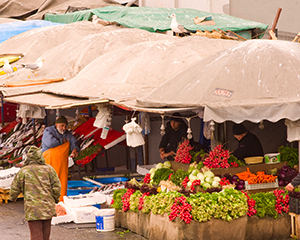 Our nomination for Best Restaurant on the Planet might well go to one of the Meyhanes of Pera and the Karaköy Docks. From the first days of Ottoman Istanbul, this district was given over to foreigners, from the Genoans and Venetians to the British and French, so the cuisine might not qualify as Turkish home cooking, but it is sensational.
Our nomination for Best Restaurant on the Planet might well go to one of the Meyhanes of Pera and the Karaköy Docks. From the first days of Ottoman Istanbul, this district was given over to foreigners, from the Genoans and Venetians to the British and French, so the cuisine might not qualify as Turkish home cooking, but it is sensational.
The term Meyhane refers to a shop that sells wine with Mezze, the Turkish form of tapas, as the start of a meal (you can also join the locals and Bulgarians in getting ploughed on Raki, the local absinthe). For the uninitiated, the choices can look a little intimidating–every form of dried, marinated, or steamed seafood, refined meats and sauces, and vegetables of every description. But what makes the food such a surprise is the delicacy of the spices, herbs, and fruits added in–from coriander and bergamot all the way to quince, lemon, and (of course!) paprika.
After the effete tastes of Vienna, the occasionally strained elegance of Budapest, and the caloric bender that is Bucharest, the clarity of Turkish cooking comes as an explosion in the senses. It is really hard to find a bad meal in Istanbul, from the street juice hawkers to the bazaar kebab shops to the thousands of local eateries.
The only exception is the place that caters almost exclusively to the tourist, all over town, but lined up one after another around the great mosques of the old city. You can spot these establishments–as you can in Paris, London, Bruxelles, or just about anywhere–by the hawker outside corralling in the unwary. Someone should tell these businesses to get rid of the hawker and invest instead in a better chef, except that the hawker usually seems to double as the owner. You won’t find hawkers outside a restaurant that is packed day and night with regulars.
And by the way, Turkish home cooking (to use one of the odder phrases in the restaurant trade) is sensational too. You just have to work a little harder to find it.
Filed under: Travels Tagged: Travel, Turkey

January 2, 2014
Pitești
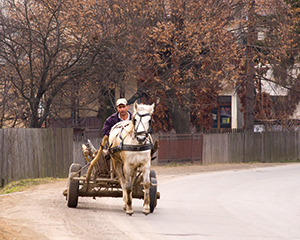 There is a saying in Romania that you can walk thirty minutes in any direction and you will find an impoverished Gypsy. In the back-country around Pitești, the saying sounds about right. The Romani were the first to be laid off in the industrial collapse that followed the end of Communism, and most have been reduced to the odd scrabble for a living that they knew before the Communists came to power.
There is a saying in Romania that you can walk thirty minutes in any direction and you will find an impoverished Gypsy. In the back-country around Pitești, the saying sounds about right. The Romani were the first to be laid off in the industrial collapse that followed the end of Communism, and most have been reduced to the odd scrabble for a living that they knew before the Communists came to power.
Firewood gathering is a major enterprise, both for sale to each other and to heat their own dwellings. You see the carts late at night on the country roads, often with a police official questioning the driver on the source of his wooden loot. A wrong answer will get the thief eight to ten years in a local jail, although fortunately not the political prison, Experimentul Pitești, that made this town infamous until its shutdown in 1952.
The term Gypsy, by the way, is no longer acceptable usage for the Romani people. It has a connotation somewhere near the epithet nigger for a black person or wetback for a Mexican-American. You still find the word in contemporary speech and literature, but its usage seems to be declining. If the current trends continue, bigots the world over will run out of acceptable insults. Maybe they’ll have to just shut up and say nothing at all?
Filed under: Travels Tagged: Romania, Travel

January 1, 2014
Fatih
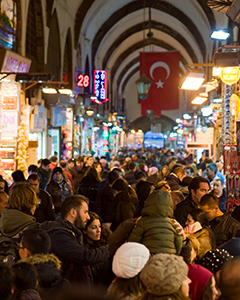 What happens when fifteen million people all decide at the same time to go shopping in the same tiny warren of downtown alleys and arcades? That’s what it feels like in the Fatih District of European Istanbul around five o’clock on New Year’s Eve. The city is enormous, and at a time like this, when everyone’s done with work and rushing out for last-minute necessities, the buses and trams just keep on coming, emptying the citizenry onto the packed squares off the Golden Horn.
What happens when fifteen million people all decide at the same time to go shopping in the same tiny warren of downtown alleys and arcades? That’s what it feels like in the Fatih District of European Istanbul around five o’clock on New Year’s Eve. The city is enormous, and at a time like this, when everyone’s done with work and rushing out for last-minute necessities, the buses and trams just keep on coming, emptying the citizenry onto the packed squares off the Golden Horn.
Like any major world megacity, Istanbul has changed almost beyond recognition in the last fifty years. It isn’t just the obvious tourist magnets, like the Kepali Casir (Grand Bazaar) and Misir Carsisi (Spice Bazaar), where the sellers of tourist trinkets are slowly edging out the legitimate, or at least traditional businesses. Or the hordes of cars, taxis, and pedestrians, which this city seems to manage better than most. The biggest change we’ve noticed–the same change we’ve seen in Italy over the last fifty years–is that the worst signs of poverty seem to have eased. The swarms of beggars, pickpockets, and petty thieves we remember from the mid-twentieth century have vanished.
It might just be that the hustle has gone up-market–this entire frantic city is packed night and day with work and hustle–but the constant nag at your wallet and pocketbook feels much more polite than in the past. The question for the rich tourist–and if you’re visiting here, you really are rich by the local standard–is whether to play your role and allow the merchants, restauranteurs, and street hawkers to gently fleece you, or to ruin your trip by worrying over every Lira that escapes your pocket.
We’ve settled for a middle road, where the more fun and clever hucksters are simply charging you for the entertainment of unmasking your innocence. The ruder, more blatant types we rebuff like we would anywhere. Oddly enough, given all the religious and cultural hype you hear these days in the Western media, no neighborhood in this city feels particularly threatening–certainly no more so than a walk down Broadway in either New York or Los Angeles or a stroll through East London or the Saint-Denis District of Paris. You might be indelibly marked as an alien in these streets, but with a little care you can walk more freely here than you can at home.
Filed under: Travels Tagged: Travel, Turkey

București
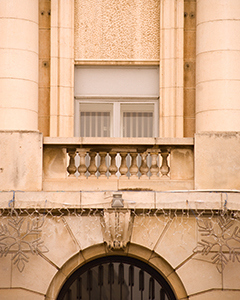 Pity the poor Nicolae Ceaușescu. His life was the ultimate expression of the homily that the road to hell is paved with good intentions.
Pity the poor Nicolae Ceaușescu. His life was the ultimate expression of the homily that the road to hell is paved with good intentions.
On the one hand, we have the hardscrabble, but immensely attractive and handsome idealist who clawed his way to the pinnacle of Romanian socialism. Along the way, he found true love in his Elena, with whom he held hands right up to their joint murder in a sad, little cellar in Tragoviste. He famously let his Elena win at backgammon, even though he constantly caught her cheating.
On the other hand, a ruthless leader who killed thousands who he imagined–correctly or not–were plotting against him. A man who could sign a death warrant with no more regret than a meter maid ridding her street of unwanted cars.
On the other hand, an iconoclast who defied the Soviets in condemning the 1968 invasion of Czekoslovakia and the eclipse of the Prague Spring.
On the other hand…
Leaders really do live to serve the people, and when they forget this, history takes its pitiless revenge. So on 21 December, 1989, when Nicolae started to speak from this rather drab Central Committee balcony in downtown Bucharest, it turned out that history had passed him by. The crowd booed, and Nicolae fled with Elena, until the helicopter and then the truck ran of fuel. When history caught up with them in a pathetic courtyard outside a dismal, rural Romanian town, it was their own people who rigged a quick trial and shot them down, no doubt to save their skins.
Did Nicolae and Elena deserve their fates? Of course they did–we all deserve the fates we conjure for ourselves. But it does seem odd that Nicolae Ceaușescu should have been the only leader who paid with his life for the political monstrosity that was the Soviet sphere of influence. Erich Honecker, Władysław Gomułka, Antonín Novotný, János Kádár, wherefore art thou?
Filed under: Travels Tagged: Romania, Travel

English
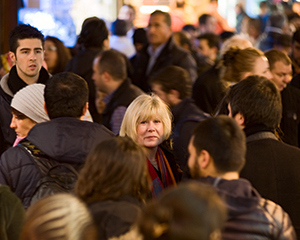 In Eastern Europe all of the way to the Bosphorus, everyone speaks English–except for the tourists. Whether it’s a French girl talking to her Romanian uncle, an Austrian passenger ordering coffee from a Turkish conductor, or an Italian with a defective passport remonstrating with a Bulgarian border guard, the foreign language–if not of choice, then of necessity–is English.
In Eastern Europe all of the way to the Bosphorus, everyone speaks English–except for the tourists. Whether it’s a French girl talking to her Romanian uncle, an Austrian passenger ordering coffee from a Turkish conductor, or an Italian with a defective passport remonstrating with a Bulgarian border guard, the foreign language–if not of choice, then of necessity–is English.
Virtually all of the natives speak a kind of Resort English. The waiter knows the words for cabbage, polenta, and dried fish. The spice seller knows every strange-scented grain and powder and the pleas it takes to talk you into buying more than you need. Everyone knows the way to the next major sight you plan on seeing. Even the ticket-window clerk knows how to say, “Stupid! You miss train! Come back tomorrow!” But virtually never will you hear a complete English sentence or phrasebook term without a heavy overlay of accent. It’s probably the season–deep winter–but the English and American travelers seem to have ventured elsewhere.
Not that we mind, but sometimes it feels like a million former high school students are just waiting for us to come along to practice their skills. The good news, of course, is that we have run into nothing but endless patience with our own klutzy and even hilarious attempts to bridge the gap with French, German, Italian, and even our own brand of Latin. As far as we can tell anyway, although we’re still wondering about a few of the meats on our plate in upper Romania.
Filed under: Travels Tagged: Austria, Bulgaria, Hungary, Romania, Travel, Turkey




